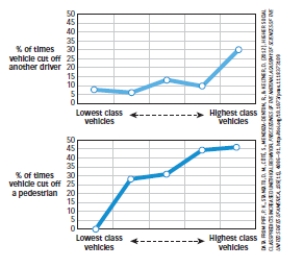Use the following to answer questions
Scenario I
Scenario I is based on and presents data from the following study (reproduced from p.25 of the textbook) :
Piff,P.K. ,Stancato,D.M. ,Côté,S. ,Mendoza-Denton,R. ,& Keltner,D.(2012) .Higher social class predicts increased unethical behavior.PNAS Proceedings of the National Academy of Sciences of the United States of America,109(11) ,4086-4091.doi:10.1073/pnas.1118373109
Piff and colleagues (2012) used naturalistic observation techniques to determine if wealthy people behaved more or less ethically than people who were not wealthy.In one study,observers stood at a busy intersection and recorded the make,model,and year of each approaching car.They also noted if the car cut off other cars or pedestrians at this intersection.
Major findings of Piff et al.(2012) are presented in Figure 1.1.This figure shows the percentage of times vehicles cut off another driver (top panel) or pedestrians (lower panel) as a function of the social status of the vehicles (with more expensive cars ranked higher in social status) .
Figure 1.1 
-(Scenario I) The researchers who conducted this study are MOST likely to be _____ psychologists.
Definitions:
Self-confidence
The belief in one’s own abilities and judgment, often seen as a critical trait for effective leadership and decision-making.
Leader Characteristics
Attributes or qualities possessed by individuals that enable them to guide, influence, or direct a group towards the achievement of goals.
Trait Approach
A framework used in psychology to study personality, focusing on the identification and measurement of specific characteristics that differentiate individuals.
Cognitive Domain
Pertains to intellectual capabilities and processes such as thinking, knowing, remembering, and problem-solving.
Q2: If Andrew is unable to find the
Q31: Current ethical guidelines prohibit conducting psychological research
Q34: The American Psychological Association existed for nearly
Q50: Identifying a group of children who watch
Q61: Humans have a natural tendency to:<br>A)notice evidence
Q66: Nature is to nurture as nativism is
Q84: The importance of the clinical work of
Q111: Beginning in the 1950s,behaviorism began to receive
Q143: Which early psychologist used the metaphor of
Q263: Tanisha ultimately wants to pursue a master's